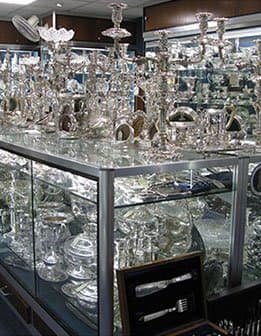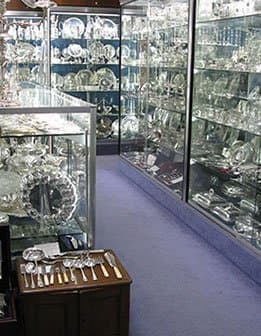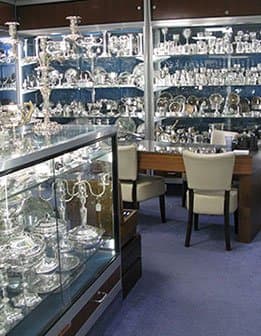Silver is a precious metal that has captured our imaginations for thousands of years. Silver plays an enormous role in all of culture and society and is treasured for its both its aesthetic beauty and incredibly useful elemental profile.
Perhaps one of the most familiar and well-known uses for silver is in the design and manufacture of silverware.
When we talk about antiques and other silverware, we are actually likely discussing sterling silver and not pure elemental silver. Sterling silver is a silver alloy, typically containing 92.5% pure silver and 7.5% other metals including copper and often small quantities of nickel and traces of other elements.
The reason sterling silver is used for creating usable objects including antique silver is because true pure elemental silver (99.9%+ purity) is very soft, malleable and ductile – too soft to serve much practical use. Whilst pure silver can be easily shaped and crafted into objects, these quickly lose their form or shape.
A Short History of Silver
Silver is one of seven antiquity-era metals that were known and used across classical and ancient civilisations including gold, copper, lead, mercury, iron and tin.
Silver has a long and illustrious history and was the choice metal for minting coins for thousands of years. The ancient Mesopotamians mined silver in the 4th millennium BCE, using it as an early form of currency. The ancient Egyptians once considered silver almost as valuable as gold and with mines spread across Spain, Greece, Italy and Anatolia, silver mining and trade was the origin of many ancient historical conflicts.
Across ancient Japan, China and Korea and in South America, silver was also highly sought after for its practical and aesthetic qualities, quickly becoming a prized metal for the richest members of society.
Silver Today
Silver is often compared to gold and platinum, but actually, it is by far the most useful metal of the trio and that’s why it is mined in much greater abundance.
Whilst platinum is used in the medical industry, e.g. for fillings, and gold in electronics manufacture due to its excellent electrical conductivity and corrosion resistance, silver is a potent antibiotic and antibacterial agent and is also used to purify water, create batteries and dye paints amongst hundreds of other uses. Silver is also the most electrically conductive element on the planet, but gold is slightly favoured in electronics due to its better corrosion resistance.
Silver’s wide range of uses means that silver is mined more abundantly than gold – some 1.5 million tons of silver have been mined vs some 200,000 tons of gold.
Despite silver’s value not quite matching up to gold and platinum, it still has an exceptionally high value and as it is used much more frequently than other precious metals, its value is expected to soar in the coming decades. Silver demand is currently high and supply is also high, but once silver resources begin to deplete – and this is forecast to happen soon – the value of silver including sterling silver could indeed spike dramatically.
Sterling Silver Antiques
Throughout several millennia of use, sterling silver has been the material of choice for many craftspeople, artists, artisans, metallurgists and others who work with metals. It is more accessible, abundant and flexible than gold; easier to shape into bolder, more complex designs.
Silversmiths such as the Bateman Family, Garrards Silversmiths and Paul Storr gained prolific status through the classical and neoclassical periods of the 1600s, 1700s and 1800s, creating fine sterling silverware for royalty, the rich aristocracy and upper classes throughout the world.
In essence, the true value of silver is brought about by its widespread use in antiques and the diversity of work for which it has facilitated.
The prized work of these silversmiths and others have become some of the finest, most sought-after items in the world of antiques.
How To Identify Sterling Silver
When you put highly polished sterling silver next to pure silver, they are quite hard to tell apart.
However, over time, sterling silver will develop a darker telltale patina that creates a soft lustre that polishes up into an impressive shine.
Sterling silver and silver can also be identified by their hallmarks or maker’s marks. Proper hallmarking was legally mandated across most of Europe in the 16th century, so most modern, classical and neoclassical pieces should be straightforward for an expert to identify.
Marks and hallmarks aren’t just there to denote whether or not a piece is sterling silver or not, but they can also provide information on the silversmith, country and date of manufacture.
Since 1973, the European Community (EC) decided for 925 to be the standard mark to denote sterling silver – identifying modern silver pieces should be easy.
Looking After Sterling Silver
Sterling silver is tough and durable, so it should look after itself. After all, this is why we can enjoy such a diverse array of antique silver today!
Most of the time, gently polishing sterling silver is the only thing you’ll need to do to maintain it. Some older sterling silver may accumulate corrosion in its grooves and crevices and this can be removed with white spirit or methylated spirit, as indicated by the Victoria and Albert Museum.
The key to polishing silver is to be gentle and to consider the piece. Some pieces will not benefit from harsh cleaning and it could also affect their value. Pieces from the 19th century, in particular, were deliberately oxidised, creating an overall darker silver tone. This should be preserved to preserve the historical provenance of the antique.
Our Makers
An A to Z list of silversmiths featured on our website
About Us
If you see something in Archive that you would have liked please contact us as we might be able to source
Our Store
Our store is situated in vaults 3 and 5 on the right-hand side of the main corridor at The London Silver Vaults



